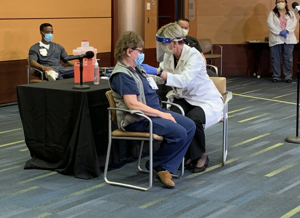Revised CDC guidance shakes up Pennsylvania’s vaccination plan

(The Center Square) – Revised federal guidance that expands the pool of Americans eligible for the COVID-19 vaccine left Pennsylvania health officials scrambling to rethink their statewide immunization plan.
Secretary of Health Dr. Rachel Levine said Wednesday that when the federal Centers for Disease Control and Prevention (CDC) said residents age 65 or older or with preexisting health conditions should move to the front of the line, the Department of Health had to shift gears.
“Things changed last night in terms of what the federal recommendations are, and we take that to heart and are working on plans now,” she told the Center for Rural Pennsylvania during a panel discussion. “They have jumbled the categories. It’s going to take time for everyone in this new category … to get vaccinated, and it will lead to a delay in other people getting vaccinated.”
The original Phase 1A included health care workers and residents of long term care facilities, but the slow pace of administration encouraged federal health officials to expand that group. Of the 25 million doses shipped to states, just 9 million have been dispensed.
“Every vaccine dose that is sitting in a warehouse rather than going into an arm could mean one more life lost,” Health and Human Services Secretary Alex Azar told reporters Tuesday.
In Pennsylvania, state records show more than 311,000 residents have been immunized since last month. The state has received nearly 1 million doses of the vaccine.
Levine said delays over the holidays stifled the state’s rollout of widespread vaccinations. The rate of administration has been improving in recent weeks, she said, but challenges still persist.
“We only get so much vaccine,” she said. “If we see it [an increase], we will put it out. We also don’t know from week to week exactly how much we are going to get until that Friday.”
Levine said the state and its pharmacy partners – like CVS and Walgreens – are coordinating on building an online system for residents to use when they are ready for immunization. The tool isn’t operable, yet, but should help connect eligible residents with the state’s limited doses.
Health officials focused on administering the vaccine in rural parts of the state said additional roadblocks – such as hesitance from younger residents and lack of manpower – make mass immunizations difficult.
“The limiting step as we get into larger groups to be immunized is staff,” said Dr. George Garrow, chief medical officer of the Primary Health Network, the state’s largest federally qualified health center. “We’ve actually had to close offices because our staff has been impacted by COVID.”
Dr. Cary Funk, director of Science and Society Research for the Pew Research Center, said about 52 percent of rural Americans indicated they’d receive the vaccine; however, younger residents without complicating risk factors show more hesitance overall. Lawmakers present for the panel discussion wondered aloud whether their public support would influence more vaccinations.
“Those who see little personal need are quite divided about whether they’d do it,” Funk said. “The more that you have people that are trusted in that community, that share the values of that community, the better.”
Disclaimer: This content is distributed by The Center Square

